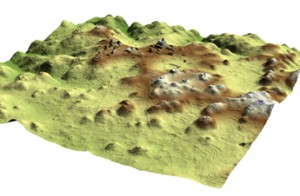Space tech aboard Cessna maps ancient civilization in days

What once took 25 years and a team of machete-wielding archaeologists has been done in a matter of days thanks to Light Detection and Ranging (LIDAR) technology.
University of Central Florida researchers have successfully used LIDAR equipment aboard a Cessna to collect the equivalent of 25 years worth of data in four days that illustrates never seen before features of a complex ancient Mayan urban center hidden beneath the forest canopy.
The twin-engine Cessna 337 flew over what was once the Maya city of Caracol last year. The NASA funded technology bounced laser beams to sensors on the ground, which penetrated beyond the rainforest and detected thousands of new structures, 11 new causeways, tens of thousands of agricultural terraces and many hidden caves. The images include elevation models that show ancient settlement and environmental modifications made by the inhabitants within 77 square miles.
The LIDAR image of the Maya landscape above shows the density of terracing in the Caracol epicenter.
Previously, Maya archeologists have been limited in exploring large sites and understanding the full nature of ancient Maya landscape modifications because most of those features are hidden within heavily forested and hilly terrain and are difficult to record. LIDAR effectively removes these obstacles.
"It's very exciting," said Arlen Chase an archaeologist who with his wife Diane, have directed archaeological excavations at Caracol for more than 25 years.
"The images not only reveal topography and built features, but also demonstrate the integration of residential groups, monumental architecture, roadways and agricultural terraces, vividly illustrating a complete communication, transportation and subsistence system," he said.
UCF Biology Professor John Weishampel designed the unique LiDAR approach. He has been using lasers to study forests and other vegetation for years, but this was the first time this specific technology fully recorded an archeological ruin under a tropical rain forest, according to UCF.
"Further applications of airborne LiDAR undoubtedly will vastly improve our understanding of ancient Maya settlement patterns and landscape use, as well as effectively render obsolete traditional methods of surveying," Chase said.
The New York Times has additional details about this research, noting other archeologists who say the technology should be a boon to explorations, especially ones in the tropics.
